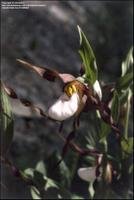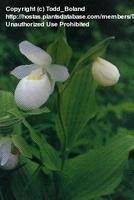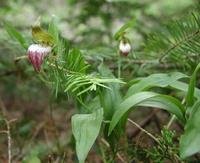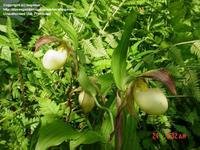





They were small strange blooms, looking very much like ballet shoes to me. We didn't gather many of them, and never the flower. We waited until it had bloomed and the plant was dying down before we gathered the root. It was to be made into a liquid that would ease the pain of a toothache.
(Editor's Note: This article was originally published on April 28, 2009. Your comments are welcome, but please be aware that authors of previously published articles may not be able to promptly respond to new questions or comments.)
The first time I ever saw a real cultivated orchid was when I was a senior in high school and my boyfriend gave me a corsage made of two pale mint green cymbidium orchids. Most girls got dyed carnations, and a few received roses, but I got orchids! I guess I never told him how special those orchids were to me, and it really would not have made much sense to him at the time because he did not know Aunt Bett. But I will never forget those orchids.
Aunt Bett and I had traveled every path up the mountains, and made some new ones of our own, in search of one plant or another in the years before I went away to college. She knew a lot about the medicinal value of plants because she had learned it at the knees of her Native American grandmother. I was always ready to accompany her on another adventure, and one spring morning we went in search of what she called the "wild orchids".
Not known for my timidity, I immediately told her that no orchids grew in the mountains, they only grew in the warm climate of the islands, and whatever made her think we would find orchids in the mountains.? I had just finished a fourth grade class in geography at the time, so I knew all about the islands. "I think you're wrong, Aunt Bett, I bet we don't find not one orchid."
Aunt Bett gave me one of her looks and just kept right on climbing. She might have mumbled something, but I didn't hear if she did. We got to the edge of a grove of evergreen trees. I don't remember what kind they were, but most likely they were cedar since cedars grew in great abundance in the mountains around my house. Peeking out from beneath the evergreens I could see a small mint green bloom, and there were many of them all clustered together beneath that cedar tree, much like baby chicks nestling under the feathered wings of the old mother hen
I stepped closer to see what it was, and truly it looked like miniature ballet shoes to me. Aunt Bett told me they were wild orchids, and that we were going to mark the plants so that we could dig up some roots later in the fall. She said she would make an infusion from the roots and use it to ease the pain of toothaches. We drove a stake, and I tied one of my hair ribbons to the top, so that we could find the wild orchid in the fall. 
Aunt Bett had just introduced me to the Lady Slipper Orchids. They are in the genus Cypripedium in the Orchidaceae family. There are about fifty species that are widespread throughout boreal, temperate and tropical regions of the continents. More than thirty species are in the Northern Hemisphere, and twelve species occur in the United States. Eleven of those are represented on National Forest system lands. They are hardy terrestrial plants that can grow in cold climates and flower in early to mid spring when there is plentiful moisture and cool temperatures. There are some that grow in Alaska that are so well adapted to cold their shoots sprout up under the snow in the spring. For centuries, Cypripedium species have been sought and collected not only for their unique beauty, but also for the medicinal trade. As a result of this and of the fact that lady's slippers have special requirements that make them difficult to cultivate, they rarely survive transplanting. In many areas, and particularly on all federal lands, it is illegal to dig or pick the wild orchids, simply because their numbers are dwindling.
The genus name Cypripedium is derived from the Greek words "cypris" an early reference to Aphrodite, and "pedilon" for sandal. This is because the fused petals that form the pouch resemble a slipper or a shoe. Thus the name: "the slipper orchids", or ladyslippers. The wild orchids have swollen ball shaped tubers that were regarded in traditional practices as having medicinal value. The root of the lady slipper was used as remedy for tooth pain, and also for nervousness. 
In order to survive and reproduce, most of the lady slippers interact with a fungus in the soil. Generally orchids do not have food supplies in them like most plants. Some of them require a fungus to break open the seed and attach itself to the orchid. The fungus then passes on food and nutrients to the lady slipper. As it gets older it produces its own nutrients, and the fungus will then extract nutrients from the orchid roots. This relationship between fungus and orchid is known as symbiosis. This is the main reason lady slipper orchids will not transplant easily. The soil must have the proper fungus in order for the orchid to grow. Under perfect conditions, the slipper orchid is a long lived herbaceous perennial. It flowers from mid-April to late May. They range in color from white to yellow, to pink and magenta, and quite often have a green or brown tint to them. They might take on a slightly different shape as you see them from place to place, but always they will have the little cupped look of a slipper.
I am more familiar with Kentucky's lady slipper. It is a large showy orchid with about 28" stems. The stems have five leaves and bear a single flower. The pouch of the flower is creamy to pale yellow with a greenish purple petal. It grows in southern hardwood forests, on damp low-lying areas near springs or mountain creeks. It is often found where wild ferns grow. The name of the Kentucky lady slipper is Cypripedium kentuckiense.
I can't begin to tell you how many times I had to climb that mountain and dig a few roots for Aunt Bett's tooth ache remedy. Sometimes she went with me, and sometimes I went alone, but always it was an hour long trip to get only a few roots. I never had a toothache, so I didn't know what all the fuss was about. When I got back to her house with a little sack of fresh roots, it was my job to wash them, then pound them with a wooden mallet to get the juices flowing. As soon as I had pounded those poor roots to death, she would immediately dump them into a pot of boiling water and there they would stay until she said they had been boiled enough. After all the boiling, the roots were strained from the liquid, and mashed to get every drop of juice out, then the juice was poured into little bottles that had cork stoppers. Whenever anybody came to her with a toothache, she would take one of the bottles and with a wooden handled cotton swab, she dabbed that orchid root infusion onto the tooth that was giving a problem. Then she would hand the person with a toothache the bottle and about six of those swabs and send them on their merry way. I don't like dentists either, so maybe I can go out and find some lady slipper root just in case I ever get a toothache.
There are many varieties of lady slipper orchids across our country. Chances are, if you have any woody areas near where you live, you will find them. And if you do, please let them stay where they are. These beautiful little lady slippers are dwindling in number, and only we can do something about that.
Sources: http://www.fs.fed.us/wildflowers/plant-of-the-week/cypripedium_acaule.shtml
http://www.fs.fed.us/wildflowers/beauty/cypripedium/index.shtml
All photos are from Plant Files. Thanks to Kwoods: yellow lady slipper; Kennedyh: mountain lady slipper; Todd_Boland: showy lady slipper; rcn8: ramshead lady slipper; and Bogman: Kentucky lady slipper.
Copyright © www.100flowers.win Botanic Garden All Rights Reserved